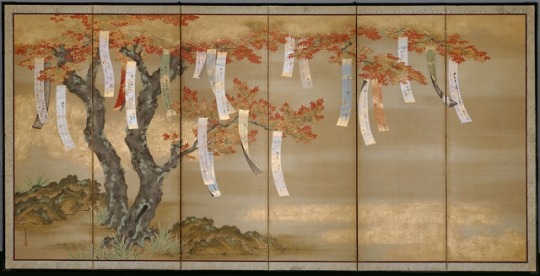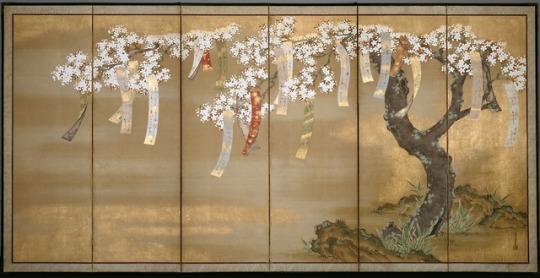#tosa mitsuoki
Explore tagged Tumblr posts
Text

3 notes
·
View notes
Text

Murasaki Shikibu (紫式部, 'Lady Murasaki'; c. 973 – c. 1014 or 1025) was a Japanese novelist, poet and lady-in-waiting at the Imperial court in the Heian period. She is best known as the author of The Tale of Genji, widely considered to be one of the world's first novels, written in Japanese between about 1000 and 1012. Murasaki Shikibu is a descriptive name; her personal name is unknown, but she may have been Fujiwara no Kaoruko (藤原香子), who was mentioned in a 1007 court diary as an imperial lady-in-waiting. | Depiction of Murasaki Shikibu by Tosa Mitsuoki| all by Wikipedia
Art by Women - Women in Arts
#MurasakiShikibu #紫式部 #LadyMurasaki #Japanesenovelist #poet #womenpoets #womenwriters Murasaki Shikibu (
3 notes
·
View notes
Photo

Autumn Maples with Poem Slips
c. 1675
Tosa Mitsuoki
9 notes
·
View notes
Text
Gallery Walk Through: Andò Gallery
Stephanie Koch Media 111 South Michigan Avenue Chicago, IL 60601 Art Institute of Chicago (161) The Andō Gallery This gallery was designed by Osakaborn architect Tadao Andō in 1922, as part of the reinstallation of the Asian art galleries in that year. It was first project in the United States for the now internationally renowned Andō. Inside this darkened, mininimalist environment, visitors are guided through 16 pillars arranged to evoke a traditional Japanese interior. Beyond the pillars, Japanese screens, ceramics, or other artworks are dramatically lit behind a nearly invisible wall of glass. Andō’s states aim was to provide the experience of Japanese spatial aesthetics in a contemporary setting. From left to right: Shigaraki Ware Jar 14th century Japan Stoneware with ash glaze Frederick and Nathalie Gooking Endowment, 1992.97 Tokoname Ware Jar 14th century Japan Stoneware with ash glaze Restricted gift of the Rice Foundation, 1989.623 Shigarki Ware Jar 16th century Japan Stoneware with ash glaze Gift of Roger Weston, 1991.14 Shigaraki Ware Jar 15th century Japan Stoneware with ash glaze Restricted gift of the Rice Foundation, 1989.624 Tokoname Ware Jar 15th century Japan Stoneware with ash glaze Avery Brundage and Louis Lutz endowments, 2002.24 Tanba Ware Jar 15th century Japan Stoneware with ash glaze Through prior gift of the American Friends of China, Mrs. William Bloom, Mrs. John Alden Carpenter, Polly Root Collier, W. Everett Fox, Newton S. Noble, Jr., and Russell Tyson, 1987.147 Artist unknown Japanese Millet Fields under Sun and Moon 17th century Pair of sixpanel screens, ink, color, and gold on paper Tiny dots of shellwhite pigment (gofun) form a pattered surface across the full heads of grain in these highly accurate on the right are painted with a rendering of millet fields. The leaves on the right are painted with a vibrant green malachite, reflecting a wash of brighter sunlight, while in the left browned plants nestle together under moonlight. Viewers who sat on tatami mats surrounded by these screens likely would have felt immersed in the billowing masses of fields. The pairing of the sun and the moon on screens dates back several centuries and carries Buddhist, Daoist, and Shintoassocitations. But it’s combination with century innovation, perhaps linked to improved framing technologies and seed strains that increasinges agricultural yields. Restricted gift of the Rice Foundation, 1989.625ab Tosa Mitsuoki Japanese,m16171691 Pair of sixpanel screens; ink, color, gold, and silver on silk In the 17th century, Japanese aristocrats enjoyed alongstanding custom of reciting classical verses during outings. Tosa Mitsuoki has here depicted the outcome of one such gathering thenreveling courtiers have departed and left behind their poems on stripsmfield to tree branches. These screens were commissioned or presented as a gift by Tofukumonin (16071678), daughter of the shogun and wife of the emperor Gominzunoo (15961680). This imperial couple’s patronage sparked in a renaissance in the court’s aesthetics. Tofukumon’in received instruction in composing verse, writing calligraphy, and other refined pastimes. She sponsored poetry gatherings in the women’s quarters of the palace, and the screens may have used as part of the decorative program for the rooms during such occasions. Kate S. Buckingham Endowment, 1977.15659
2 notes
·
View notes
Text

Murasaki Shikibu composing Genji Monogatari (Tale of Genji) by Tosa Mitsuoki (1617-1691).
3 notes
·
View notes
Text
Julie Demboski's ASTROLOGY - Notes on November-December 2024: In Spite Of via @jdem759
0 notes
Text

Japanese autumn maples with poem slips (1649–1686), by Tosa Mitsuoki.
1 note
·
View note
Text

"Truyện Genji" của Nhật - hơn 1.000 năm tuổi, kể đời sống tình ái của một hoàng tử - còn được coi là tiểu thuyết đầu tiên trên thế giới. Ngày 18/4, Pen-house - một trong những thương hiệu văn phòng phẩm lớn nhất tại Nhật Bản - ra mắt loại mực in mới được đặt tên là Truyện Genji (Genji-monogatari). Theo lời giới thiệu từ nhà sản xuất, họ lấy cảm hứng từ cuốn sách nổi tiếng để tạo ra "loại mực nguyên bản với chất lượng, màu sắc trang nhã, thể hiện đậm nét văn hóa, truyền thống của Nhật". Theo nhiều chuyên gia, cuốn sách được viết từ đầu thế kỷ 11 đến nay vẫn có tầm ảnh hưởng sâu rộng. Bức tranh "Murasaki Shikibu ngắm trăng" của họa sĩ Mitsuoki Tosa vẽ thế kỷ 17, được trưng bày ở đền Ishiyamadera. Ảnh: Ishiyamadera Temple Tác giả Murasaki Shikibu sinh khoảng năm 978, mất sau năm 1019, thuộc dòng họ quý tộc Fujiwara. Thực tế "Murasaki" là bút hiệu các học giả đặt cho bà, còn "Shikibu" là tước vị bà thừa hưởng từ cha. Tên thật và nơi sinh của tác giả vẫn chưa được xác định. Theo sử sách Nhật Bản, các thành viên gia đình Shikibu đều là những học giả và thi sĩ xuất chúng, trong đó nổi bật nhất là Murasaki. Năm 26 tuổi, bà theo hầu thứ phi Akiko trong triều đình của Thiên hoàng Ichijo (986-1011). Đây cũng là khoảng thời gian cực thịnh của thời kỳ Heian (794-1185).Hiện vẫn còn những tranh cãi về thời điểm Shikibu bắt đầu viết Truyện Genji. Mốc thời gian nhận được nhiều đồng thuận nhất là năm 1003 - hai năm sau khi chồng bà qua đời. Tác phẩm dài 54 chương, gồm hai phần chính: Phần đầu có 40 chương, kể về cuộc đời Hoàng tử Hikaru Genji với những cuộc phiêu lưu tình ái, đồng thời khắc họa chân dung nhiều nhân vật nữ có quan hệ thân thiết với Genji. Phần sau gồm 14 chương là câu chuyện về Kaoru - người con của Genji trên danh nghĩa. Sách tập trung miêu tả tình yêu và tâm lý nhân vật. Tác giả tạo ra một thế giới sống động, lột tả chi tiết đời sống, sinh hoạt, tư duy không chỉ của giới quý tộc mà còn của cả tầng lớp dân thường.Nhiều độc giả coi Truyện Genji như bách khoa toàn thư...

0 notes
Photo

Painting of a maple tree in autumn by Tosa Mitsuoki (1617–1691)
22 notes
·
View notes
Photo

Autumn Maples with Poem Slips
Tosa Mitsuoki, c. 1675 Six-panel screen (one of pair); Ink, colors, gold leaf, and gold powder on silk
236 notes
·
View notes
Text

Autumn Maples with Poem Slips (Detail) Tosa Mitsuoki
2 notes
·
View notes
Photo

Autumn Maples with Poem Slips, Tosa Mitsuoki, 1675
#autumn maples with poem slips#tosa mitsuoki#1675#1670s#1600s#17th century#screen#painting#art#nature
16 notes
·
View notes
Text


“Autumn Maples with Poem Slips Date:
c. 1675
Artist: Tosa Mitsuoki
Japanese, 1617-1691
ABOUT THIS ARTWORK
“Japanese aristocrats engaged in the elegant custom of recollecting classical poetry while viewing spring and autumn foliage. In these delicate screens, premier court painter Tosa Mitsuoki meditated on the inevitable passage of beauty by depicting the melancholy hours after the departure of reveling courtiers. A cherry tree bursts into bloom on the right screen (seen here at top), while its mate displays the brilliant red and gold foliage of maples in autumn. Slips of poetry, called tanzaku, waft from the blossoming limbs, the remaining evidence of a human presence. Courtiers (whose names are recorded in a seventeenth-century document) assisted Mitsuoki by inscribing the narrow strips with quotations of appropriate seasonal poetry from twelfth- and thirteenth-century anthologies. The screens were either commissioned by or given to Tofukumon’in (1607–1678), a daughter of the Tokugawa shogun who married the emperor Gomizunoo (1596–1680). In an era otherwise marked by increasing control of the feudal shogunate over imperial prerogatives, this royal couple encouraged a renaissance of courtly taste that nostalgically evoked the past glories of early-medieval aristocratic life.
— Entry, Essential Guide, 2013, p. 110.”
658 notes
·
View notes
Photo


‘Autumn Maples and Flowering Cherry with Poem Slips’ (circa 1675) by Tosa Mitsuoki (Japanese, 1617-1691).
Pair of six-panel screens. Ink, colours, gold leaf, and gold powder on silk.
Images and text information courtesy Art Institute Chicago.
101 notes
·
View notes
Photo



Tosa Mitsuoki (1617 - 1691)
Original name Tosa Fujimitsu, also called Tsuneaki
Murasaki Shikibu Composing ‘The Tale of Genji’, 17th century, Edo period, hanging scroll; ink and color on silk; image: 35 5/8 × 20 3/4 inches, lent by Ishiyamadera Temple (photo courtesy Ishiyamadera; image courtesy The Metropolitan Museum of Art, New York)
A Japanese Classic, Dimly Illuminated
The visual images interpreting The Tale of Genji, the world’s first novel, which was written by a woman, are presented as beautiful objects devoid of context. -David Carrier, 2019, Hyperallergic
‘The Tale of Genji,” written by Murasaki Shikibu around 1,000 A.D., is regarded by many as the world’s first novel and is arguably the most influential work of Japanese literature ever written, inspiring countless other works of drama, fiction and fine art. “It took me 15 years of steady, almost daily, work,” says Dennis Washburn, a professor at Dartmouth College in the U.S. who recently joined the elite corps of translators that have produced English-language versions of Murasaki’s classic.
A novel that relates the life story of Prince Genji — an illegitimate but beloved son of the Emperor — and his many love affairs. Unusually, the novel also continues to follow the intrigues and disappointments of a second generation of characters close to the Imperial throne. -New translation of the world's oldest novel, The Japan Times
#Genji#Tosa Mitsuoki#Illustration#novel#book#Japan#Murasaki Shikibu#Dennis Washburn#classic#literature#research
10 notes
·
View notes
Photo

Tosa Mitsuoki (1617 - 1691) - Autumn Maples with Poem Slips c.1675. Six panel screen. Ink, colour, gold leaf and gold powder on silk.
Click to enlarge.
24 notes
·
View notes